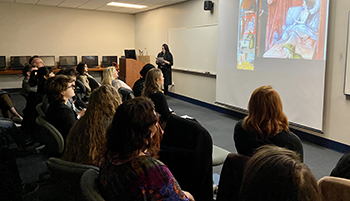The Power of Non-Gender Specific Imagery: An Analysis of Eighteenth-Dynasty Egyptian Iconography and the Use of Androgyny to Propagate Power and Right to Rule
Description/Abstract/Artist Statement
The Power of Non-Gender Specific Imagery: An Analysis of Eighteenth-Dynasty Egyptian Iconography and the use of Androgyny to Propagate Power and Right to Rule
New political realities during the New Kingdom forced corresponding changes in the gendering of traditional leadership roles. Eighteenth-dynasty kings and queens were depicted in ways that departed from traditional gendering of Egyptian political offices, for example Hatshepsut is shown feminine, challenging the maleness of kingship, and Akhenaten is depicted in ways that obscure his gender. Previous scholarship has tended to view the use of androgyny and femininity by eighteenth-dynasty kings as separate phenomena grounded in the individual and distinct political needs of each ruler. I propose that such challenges to traditional gendering of power in Egyptian society were all part of a single phenomenon endemic to the eighteenth dynasty. For the royal family, androgyny was used to connect kings to the divine.
Kristina Hilliard observes that the iconography of Egyptian female kings presented a form of distinctly female power. Hilliard overlooks, however, the fact the evoking gender in flexible ways was used by both male and female rulers in the eighteenth dynasty. A focus exclusively on female kings and rulers neglects the family ties that coursed through the eighteenth dynasty and that surely played a role in how kings of that period chose to present their gender. Androgyny, specifically, served as a way to link them to the divine. In Hatshepsut’s case, androgyny visually linked her to Horus, who is male and critical to Egyptian Kingship. For Akhenaten, androgyny strengthened his own connection to the Aten, a genderless deity. In both cases, these connections reinforced the kings’ right to rule.
Faculty Advisor/Mentor
Jared Benton
Presentation Type
Oral Presentation
Disciplines
Ancient, Medieval, Renaissance and Baroque Art and Architecture
Session Title
College of Arts & Letters 5
Location
Learning Commons @ Perry Library Room 1306
Start Date
2-8-2020 11:30 AM
End Date
2-8-2020 12:30 PM
The Power of Non-Gender Specific Imagery: An Analysis of Eighteenth-Dynasty Egyptian Iconography and the Use of Androgyny to Propagate Power and Right to Rule
Learning Commons @ Perry Library Room 1306
The Power of Non-Gender Specific Imagery: An Analysis of Eighteenth-Dynasty Egyptian Iconography and the use of Androgyny to Propagate Power and Right to Rule
New political realities during the New Kingdom forced corresponding changes in the gendering of traditional leadership roles. Eighteenth-dynasty kings and queens were depicted in ways that departed from traditional gendering of Egyptian political offices, for example Hatshepsut is shown feminine, challenging the maleness of kingship, and Akhenaten is depicted in ways that obscure his gender. Previous scholarship has tended to view the use of androgyny and femininity by eighteenth-dynasty kings as separate phenomena grounded in the individual and distinct political needs of each ruler. I propose that such challenges to traditional gendering of power in Egyptian society were all part of a single phenomenon endemic to the eighteenth dynasty. For the royal family, androgyny was used to connect kings to the divine.
Kristina Hilliard observes that the iconography of Egyptian female kings presented a form of distinctly female power. Hilliard overlooks, however, the fact the evoking gender in flexible ways was used by both male and female rulers in the eighteenth dynasty. A focus exclusively on female kings and rulers neglects the family ties that coursed through the eighteenth dynasty and that surely played a role in how kings of that period chose to present their gender. Androgyny, specifically, served as a way to link them to the divine. In Hatshepsut’s case, androgyny visually linked her to Horus, who is male and critical to Egyptian Kingship. For Akhenaten, androgyny strengthened his own connection to the Aten, a genderless deity. In both cases, these connections reinforced the kings’ right to rule.


